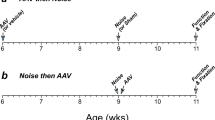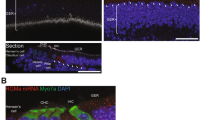Abstract
Hearing is conveyed from the auditory receptors, the hair cells in the organ of Corti, to the brain via the spiral ganglion neurons. Damage or loss of either spiral ganglion neurons or hair cells causes hearing impairment. Such hearing disorders are often permanent and can be caused by therapeutic agents, such as aminoglycoside antibiotics and cisplatin, or by aging, loud sounds, infections and mechanical injury1. Brain–derived neurotrophic factor (BDNF) and neurotrophin–3 (NT–3), members of the neurotrophin family of neurotrophic factors that also include nerve growth factor (NCF) and neurotrophln–4/5 (NT–4), are important in development of the neuronal components of the inner ear. We report here that the loss of target innervation and the degeneration of approximately 90% of the adult spiral ganglion neurons caused by aminoglycoside toxicity can be prevented by infusion of the neurotrophic factor, neurotrophin–3 (NT–3) in the membranous labyrinth in guinea pigs. The potency of NT–3 in protecting spiral ganglion neurons from degenerating suggests that neurotrophins may be useful for the treatment of hearing disorders.
This is a preview of subscription content, access via your institution
Access options
Subscribe to this journal
Receive 12 print issues and online access
$209.00 per year
only $17.42 per issue
Buy this article
- Purchase on Springer Link
- Instant access to full article PDF
Prices may be subject to local taxes which are calculated during checkout
Similar content being viewed by others
References
Paparella, M.M. & Shumrick, D.A. (eds.) Otolaryngology. 1817 (Saunders, Philadelphia, 1980).
Ernfors, P., Merlio, J.-P. & Persson, H. Cells expressing mRNA for neurotrophins and their receptors during embryonic rat development. Eur. J. Neurosci. 4, 1140–1158 (1992).
Pirvola, U. et al. Brain-derived neurotrophic factor and neurotrophin 3 mRNAs in the peripheral target fields of developing inner ear ganglia. Proc. Natl. Acad. Sci. USA 89, 9915–9919 (1992).
Ylikoski, J. et al. Expression patterns of neurotrophin and their receptor mRNAs in the rat inner ear. Hear Res. 65, 69–78 (1993).
Avila, M.A. et al. Brain-derived neurotrophic factor and neurotrophin-3 support survival and neuritogenesis response of developing cochleovestibular ganglion neurons. Dev. Biol. 159, 266–275 (1993).
Davies, A.M., Thoenen, H. & Barde, Y.-A. The response of chick sensory neurons to brain-derived neurotrophic factor. J. Neurosci. 6, 1897–1904 (1986).
Lefebvre, P.P. et al. Neurotrophins affect survival and neuritogenesis by adult injured auditory neurons in vitro. Neuroreport 5, 865–868 (1994).
Represa, J. et al. Brain-derived neurotrophic factor and neurotrophin-3 induce cell proliferation in the cochleovestibular ganglion through a glycosyl-phophatidylinositol signaling system. Dev. Biol. 159, 257–265 (1993).
Vazquez, E. et al. Pattern of trkB protein-like immunoreactivity in vivo and the in vitro effects of brain-derived neurotrophic factor (BDNF) on developing cochlear and vestibular neurons. Anat. Embryol. (Berl.) 189, 157–67 (1994).
Zheng, J.L., Stewart, R.R. & Gao, W.-Q. Neurotrophin-4/5 enhances survival of cultured spiral ganglion neurons and protects them from cisplatin neurotoxicity. J. Neurosci. 15, 5079–5087 (1995).
Ernfors, P., Lee, K-F., Kucera, J. & Jaenisch, R. Lack of neurotrophin-3 leads to deficiencies in the peripheral nervous system and loss of limb proprioceptive afferents. Cell 77, 503–512 (1994).
Ernfors, P., Van De Water, T.R., Loring, J. & Jaenisch, R. Complementary roles of BDNF and NT-3 in auditory and vestibular development. Neuron 14, 1153–1164 (1995).
Farinas, I., Jones, K.R., Backus, C., Wang, X.Y. & Reichardt, L.F. Severe sensory and sympathetic deficits in mice lacking neurotrophin-3. Nature 369, 658–61 (1994).
Ernfors, P., Lee, K-F. & Jaenisch, R. Mice lacking brain-derived neurotrophic factor develop with sensory deficits. Nature 368, 147–150 (1994).
Axdorph, U., Laurell, G. & Björkholm, M. Monitoring hearing during treatment of leukemia with special reference to the use of amikacin. J. Intern. Med. 233, 401–407 (1993).
Bichler, E., Spoendlin, H. & Rauchegger, H. Degeneration of cochlear neurons after amikacin intoxication in the rat. Arch. Otorhinolaryngol. 237, 201–208 (1983).
Hinojosa, R. & Lerner, S.A. Cochlear neural degeneration without hair cell loss in two patients with aminoglycoside ototoxicity. J. Infect Dis. 156, 449–455 (1987).
Koitchev, K., Guilhaume, A., Cazals, Y. & Aran, J.-M. Spiral ganglion changes after massive aminoglycoside treatment in the guinea pig. Acta Otolaryngol. 94, 431–438 (1982).
Kumana, C.R. & Yuen, K.Y. Parenteral aminoglycoside therapy: Selection, administration and monitoring. Drugs 47, 902–913 (1994).
Matz, G.J. Aminoglycoside cochlear toxicity. Otolaryngol. Clin. North Am. 26, 705–712 (1993).
Lewin, G.R. & Barde, Y.-A. Physiology of the neurotrophins. Annu. Rev. Neurosci. 19, 289–317 (1996).
Crowley, C. et al. Mice lacking nerve growth factor display perinatal loss of sensory and sympathetic neurons yet develop basal forebrain cholinergic neurons. Cell 76, 1001–1011 (1994).
Jones, K.R., Farinas, I., Backus, C. & Reichardt, L.F. Targeted disruption of the BDNF gene perturbs brain and sensory neuron development but not motor neuron development. Cell 76, 989–999 (1994)
Lewin, G.R. & Mendell, L.M. Nerve growth factor and nociception. Trends Neurosci. 19, 353–359 (1993).
Hory-Lee, F., Russel, M., Lindsay, R.M. & Frank, E. Neurotrophin-3 supports the survival of developing muscle sensory neurons in culture. Proc. Natl. Acad. Sci. USA 90, 2613–2617 (1993).
Oakley, R.A., Garner, A.S., Largge, T.H. & Frank, E. Muscle sensory neurons require neurotrophin-3 from peripheral tissues during the period of normal cell death. Development 121, 1341–1350 (1995).
Arvidsson, J. et al. Effects of NT-3 and TrkC manipulations on developing Merkel innervation in the mystacial pad of the mouse. Soc. Neurosci. abstract (1995).
Barbacid, M. The trk family of neurotrophin receptors. J. Neurobiol. 25, 1386–1403 (1994).
Henley, C.M. & Ryback, L.P. Developmental ototoxicity. Otolaryngol. Clin. North Am. 26, 857–871 (1993).
Tran Ba Huy, P. et al. Pharmacokinetics of gentamicin in perilymph and en-dolymph of the rat as determined by radioimmunoassay. J. Infect. Dis. 143, 476–486 (1981).
Tran Ba Huy, P., Benard, P. & Schacht, J. Kinetics of gentamicin uptake and release in the rat. J. Clin. Invest. 77, 1492–1500 (1986).
Luo, L., Koutnouyan, H., Baird, A. & Ryan, A.F. Acidic and basic FGF mRNA expression in the adult and developing rat cochlea. Hear. Res. 69, 182–193 (1993).
Pirvola, U. et al. The site of action of neuronal acidic fibroblast growth factor is the organ of Corti of the rat cochlea. Proc. Natl. Acad. Sci. USA 92, 9269–9273 (1995).
Thompson, S.W. et al. Cisplatin neuropathy. Cancer 54, 1269–1275 (1984).
Estrem, S.A., Babin, R.W., Ryu, J.H. & Moore, K.C. cis-Diamminedichloroplatinum (II) ototoxicity in the guinea pig. Otolaryngol. Head Neck Surg. 89, 638–645 (1981).
Fleischman, R.W., Stadnicki, S.W., Ethier, M.F. & Schaeppi, U. Ototoxicity of ds-dichlorodiammine platinum (II) in guinea pig. Toxicol. Appl. Pharmacol. 33, 320–332 (1975).
Konishi, T., Gupta, B.N. & Prazma, J. Ototoxicity of ds-dichlorodiammine platinum (II) in guinea pig. J. Otolaryngol. 4, 18–26 (1983).
Nakai, Y. et al. Ototoxicity of the anticancer drug cisplatin. Acta Otolaryngol. 93, 227–232 (1982).
Gao, W.Q. et al. Neurotrophin-3 reverses experimental cisplatin-induced peripheral sensory neuropathy. Ann. Neurol. 38, 30–37 (1995).
Canlon, B., Marklund, K. & Borg, E.J. Measures of auditory brain stem responses distortion product otoacoustic emissions, hair cell loss, and forward masked tuning curves in the waltzing guinea pig. J. Acoust. Soc. Am. 94, 1140–1158 (1992).
Author information
Authors and Affiliations
Rights and permissions
About this article
Cite this article
Ernfors, P., Li Duan, M., Elshamy, W. et al. Protection of auditory neurons from aminoglycoside toxicity by neurotrophin-3. Nat Med 2, 463–467 (1996). https://doi.org/10.1038/nm0496-463
Received:
Accepted:
Issue Date:
DOI: https://doi.org/10.1038/nm0496-463
This article is cited by
-
Stimulation of synapse formation between stem cell-derived neurons and native brainstem auditory neurons
Scientific Reports (2017)
-
Aminoglycoside Increases Permeability of Osseous Spiral Laminae of Cochlea by Interrupting MMP-2 and MMP-9 Balance
Neurotoxicity Research (2017)
-
Attenuation of noise-induced hearing loss using methylene blue
Cell Death & Disease (2014)
-
Auditory-Nerve Responses to Varied Inter-Phase Gap and Phase Duration of the Electric Pulse Stimulus as Predictors for Neuronal Degeneration
Journal of the Association for Research in Otolaryngology (2014)



